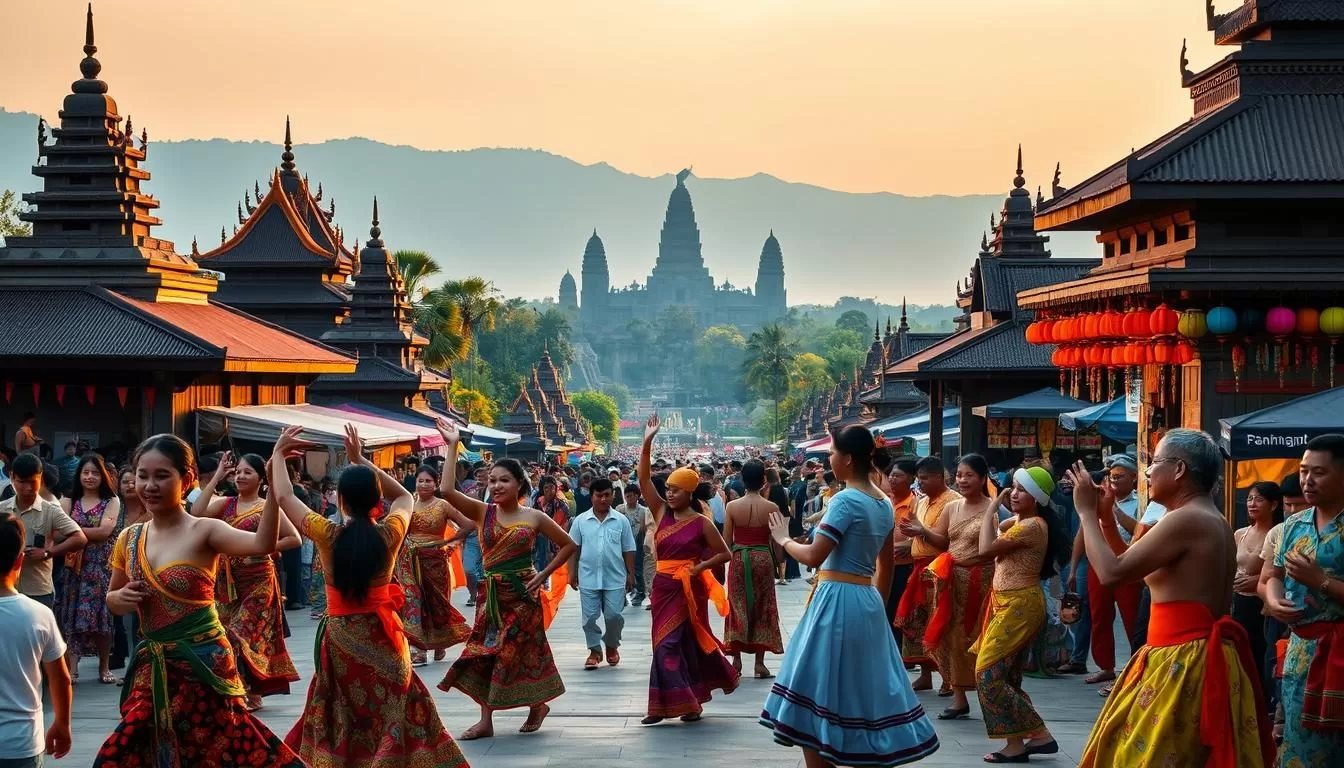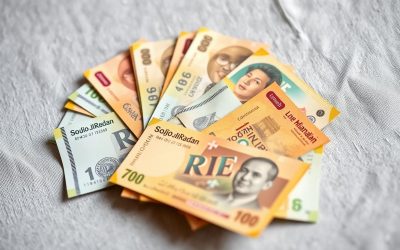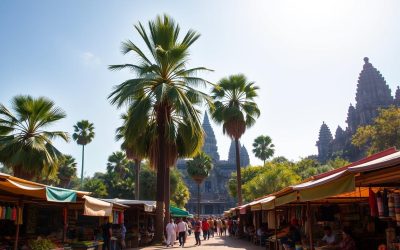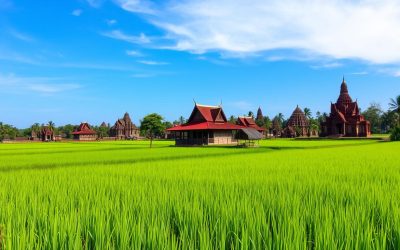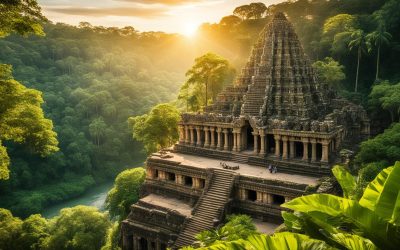When traveling to Cambodia, you’re not just visiting a country; you’re immersing yourself in a rich cultural heritage. The festivals in Cambodia are a testament to the nation’s deep-rooted traditions and celebrations that bring people together.
Cambodian festivals are intricately linked with Theravada Buddhist rituals, reflecting the country’s spiritual fabric. These events are a vibrant display of culture and community, offering a unique experience for travelers.
By experiencing these festivals, you’ll gain a deeper understanding of Cambodia’s history, values, and traditions. Whether it’s the joyous Khmer New Year or the solemn Pchum Ben, each festival provides a window into the soul of Khmer culture.
Experiencing Cambodia’s Cultural Heritage Through Festivals
Cambodian festivals offer a unique glimpse into the nation’s complex cultural landscape. These festivals are not just celebrations; they’re a reflection of Cambodia’s rich and varied cultural history. Most of the celebrations follow the Khmer lunar cycle, drawing inspiration from Buddhism, Hinduism, and old royal customs.
The lunar calendar system determines the dates of these festivals, creating a unique rhythm to Cambodia’s cultural year. As you participate in these events, you’ll discover how they serve as living museums, preserving ancient traditions. You’ll also learn how these celebrations reflect Cambodia’s complex religious landscape and strengthen community bonds.
- Preserving ancient traditions that date back to the Angkor period
- Reflecting Cambodia’s complex religious landscape
- Following the lunar calendar system
- Strengthening community bonds among Cambodians
- Offering an authentic glimpse into Cambodian daily life and spiritual beliefs
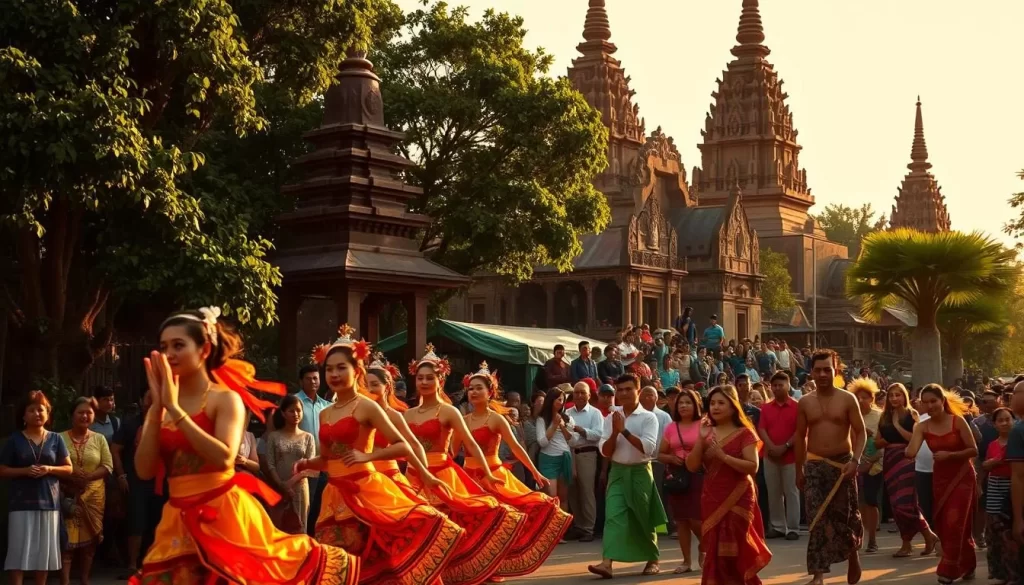
By experiencing these festivals, you’ll gain a deeper understanding of Cambodia’s culture and the significance of these events in the country’s calendar. Each festival tells a story about Cambodia’s agricultural cycles, spiritual beliefs, or historical events, providing a rich cultural experience.
Khmer New Year: Cambodia’s Most Celebrated Festival

Khmer New Year is a time-honored tradition in Cambodia, symbolizing renewal, purification, and family bonding. This significant festival marks the end of the harvest season and the beginning of the rainy season, typically celebrated on April 13th or 14th.
The three-day celebration is a time for relaxation, family reunions, and cultural and religious festivities. During this period, Cambodians engage in various traditional activities, including cleaning their homes, visiting temples, and participating in games like Bos Angkunh (tug-of-war) and Chol Chhoung (ball-throwing).
Traditional Activities During Khmer New Year
Traditional activities during Khmer New Year are deeply rooted in Cambodian culture. People clean their homes, visit temples, and participate in traditional games. Water plays a significant role in the celebration, symbolizing purification and the washing away of past sins and bad luck.
Best Places to Experience Khmer New Year
To experience the authentic spirit of Khmer New Year, visit rural villages where traditions remain strong, or temple complexes like Angkor Wat, where religious ceremonies take place. You can also join in the lively water fights and festivities in cities like Siem Reap and Phnom Penh.
As you plan your visit during Khmer New Year, be aware that many businesses may close, and locals will be celebrating with their family. This unique atmosphere creates a memorable experience, allowing you to connect with the local culture and community.
Water Festival: Celebrating Cambodia’s Unique River Phenomenon
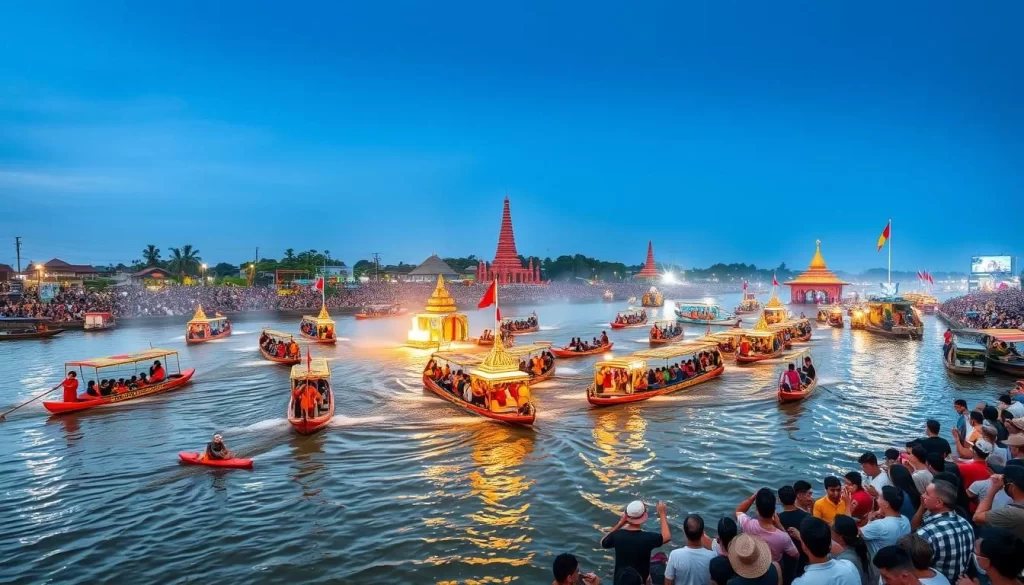
You’ll experience the vibrant Water Festival in Cambodia, a joyous celebration that marks the end of the rainy season and the beginning of the fishing season. This significant event is a testament to Cambodia’s rich cultural heritage and its people’s deep connection with water.
The Water Festival, known as Bon Om Touk, is an annual celebration held in Phnom Penh, typically occurring in November over three days. It commemorates the reversal of the flow between the Mekong and Tonle Sap rivers, a unique natural phenomenon. This event is not only a celebration but also a way for Cambodians to thank the water god for abundant water and pray for the next harvest.
Boat Racing Traditions
The Water Festival features spectacular boat races, with teams competing on the Tonle Sap River. These races have ancient traditions, originally serving as naval battle training, now representing regional pride and community spirit. Hundreds of colorful longboats participate, making it a thrilling spectacle.
Experiencing the Water Festival as a Visitor
As a visitor, you can enjoy the Water Festival by watching the boat races from the best viewing spots in Phnom Penh. The festival also includes illuminated floats, fireworks displays, and traditional music performances, creating a carnival atmosphere. To make the most of your visit, plan ahead and arrive early to secure a good viewing spot.
The Water Festival is a unique experience that connects you with Cambodia’s agricultural heritage and water-dependent way of life. With its rich traditions and vibrant celebrations, it’s an event not to be missed.
Pchum Ben: Cambodia’s Unique Festival of the Dead
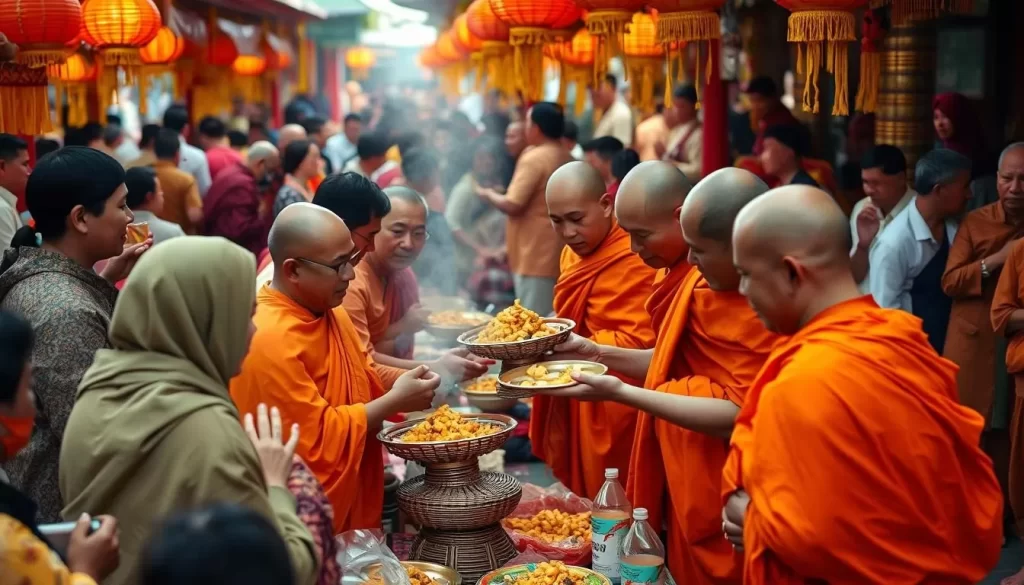
Pchum Ben, a 15-day festival culminating on the 15th day of the 10th Khmer month, is a time for Cambodians to honor their ancestors. This significant celebration, also known as Ancestor’s Day or the Festival of the Dead, is a period when the gates of hell are believed to open temporarily, allowing the spirits of ancestors to receive offerings from their living relatives.
During Pchum Ben, families gather together and visit temples and pagodas to pay their respects and offer food to monks. The food offered, particularly the traditional rice balls known as “bay ben,” is believed to be passed on to the spirits, alleviating their suffering and reducing the sins of the ancestors.
Rituals and Offerings During Pchum Ben
The rituals during Pchum Ben are centered around honoring up to seven generations of ancestors. The preparation of special rice balls (bay ben) is a crucial part of these rituals, as these offerings are believed to benefit the wandering spirits who cannot find peace in the afterlife. Monks serve as intermediaries between the living and the dead, receiving offerings that are believed to benefit the ancestral spirits.
By participating in Pchum Ben as a respectful visitor, you can gain unique insights into Cambodian spiritual beliefs and family values. The festival is a testament to the deep respect Cambodians have for their family lineage and their ancestors.
Royal Ceremonies: Ancient Traditions of the Cambodian Monarchy
The Cambodian monarchy is known for its ancient traditions, including the Royal Ploughing Ceremony. This significant event is a testament to the country’s rich cultural heritage and its deep connection to agriculture. Every year in May, typically on the fourth day of the waning moon in the sixth lunar month, the Royal Ploughing Ceremony is performed to mark the traditional start of the rice-growing season and forecast the crop yield for the following year.
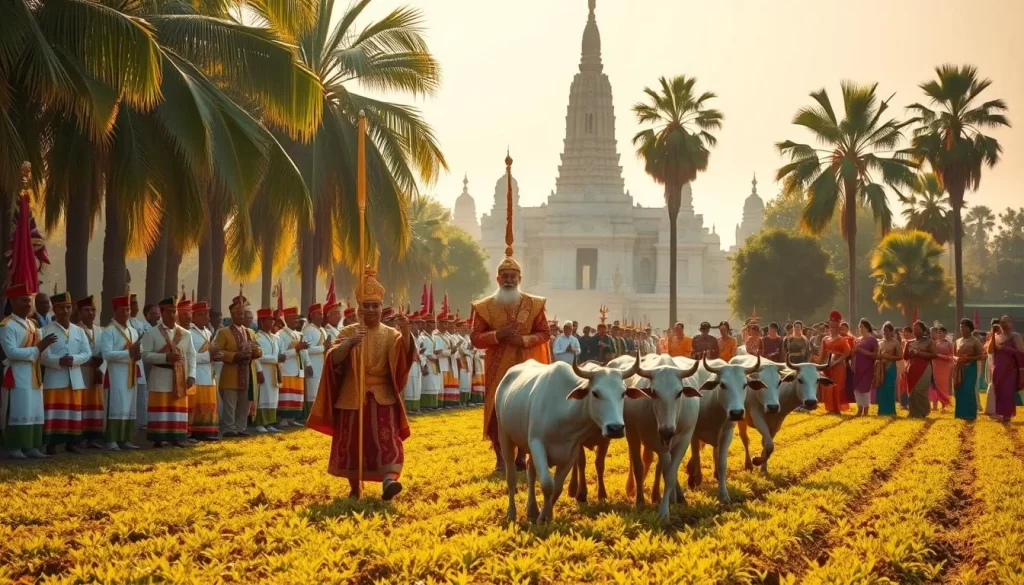
The ceremony is a means of offering thanks and praise to the spirits and deities for the safeguarding of the people and the land. The monarch or his delegate oversees the ritual, directing the plowing of a commemorative area using a couple of imperial oxen. Four female royal officers then distribute seeds of rice on the creases, symbolizing the beginning of the harvesting year and the fertile state of the land.
The Royal Ploughing Ceremony’s Agricultural Predictions
The Royal Ploughing Ceremony also includes an agricultural prediction aspect, where the royal oxen are presented with various foods, and their choices are interpreted as forecasts for the coming year’s harvest. The oxen are driven to a location where seven plates filled with food are provided, including rice, beans, maize, sesame, greens, water, and wine. The diet that the ox consumes is believed to predict the crops that will be abundant or scarce, the amount of rain or drought, and other occurrences in the upcoming year.
- The Royal Ploughing Ceremony is an ancient tradition dating back to the Funan period (1st-6th century).
- The ceremony represents the deep connection between the Cambodian monarchy, agriculture, and spiritual beliefs.
- The ritual plowing and seed-sowing performed by royal representatives symbolize the monarchy’s connection to the agricultural foundation of Cambodian society.
Buddhist Celebrations: Spiritual Festivals in Cambodia
As you explore Cambodia’s vibrant festival scene, you’ll discover the profound impact of Buddhist traditions on the country’s spiritual landscape. Buddhist festivals are a cornerstone of Cambodian culture, reflecting the nation’s deep-rooted spiritual practices and values.
Two significant Buddhist festivals in Cambodia are Meak Bochea and Vesak Bochea. Meak Bochea, celebrated on the full moon day of the third lunar month, commemorates Buddha’s sermon to 1,250 enlightened disciples. On this day, monks meditate and pray, while locals offer necessities and participate in candle ceremonies at temples, symbolizing their reverence for the Triple Gem of Buddhism.
Temple Ceremonies and Processions
Temple ceremonies are at the heart of Buddhist festival celebrations. During these events, monks lead meditation sessions and dharma talks, while devotees offer food and other necessities to the monastic community. The evening processions, where participants circle the temple three times with candles, incense, and flowers, are particularly meaningful, representing the core principles of Buddhism.
Vesak Bochea, also known as Buddha’s Birthday, is another significant celebration, honoring Buddha’s birth, enlightenment, and passing into nirvana. On this day, Buddhists in Cambodia pray to Lord Buddha and donate food and clothes to local monks, fostering a sense of community and spiritual growth.
| Festival | Date | Significance |
|---|---|---|
| Meak Bochea | Full moon day of the third lunar month | Commemorates Buddha’s sermon to 1,250 disciples |
| Vesak Bochea | Full moon day of the fourth Buddhist month | Honors Buddha’s birth, enlightenment, and passing into nirvana |
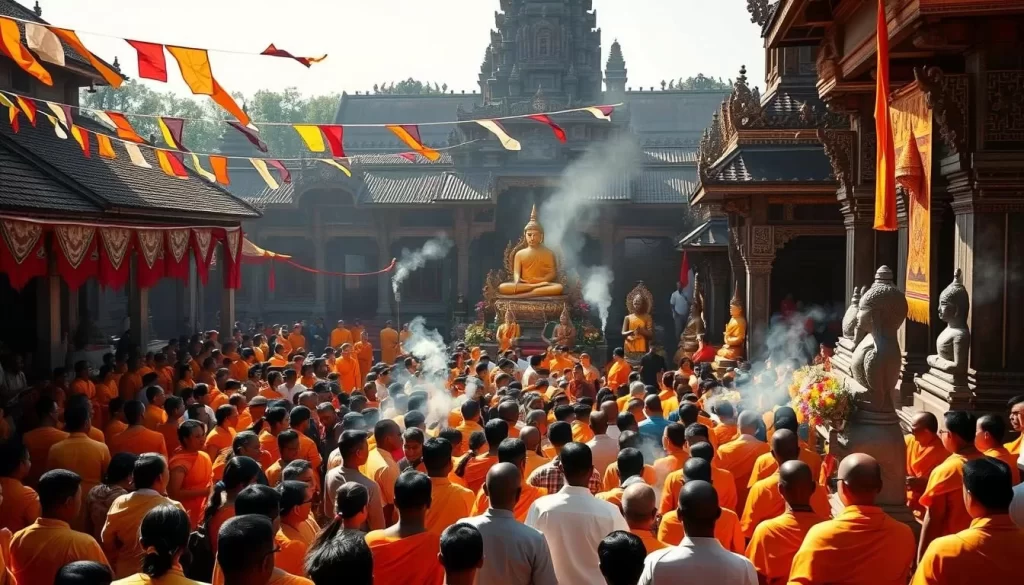
These Buddhist celebrations not only provide a serene and contemplative atmosphere but also offer visitors a unique opportunity to experience Cambodia’s rich spiritual heritage. By participating in or observing these ceremonies, you can gain a deeper understanding of the country’s cultural and religious traditions.
Tips for Attending Cambodian Festivals as a Visitor
Traveling to Cambodia during its festivals can be a captivating experience, allowing you to witness the country’s traditions firsthand. As you travel to this beautiful country, attending one of its vibrant festivals can be a highlight of your journey.
To make the most of your experience, it’s essential to be aware of certain guidelines. For instance, during major festivals in Phnom Penh, many shops, cafes, and restaurants close as locals return to their hometowns, potentially leaving urban areas understaffed.
Cultural Etiquette During Religious Festivals
When visiting temples during religious festivals, it’s crucial to respect local customs. Dress modestly, and be mindful of your behavior around monks. Understanding and adhering to these guidelines will enhance your experience and show respect for the locals.
Additionally, learning a few basic Khmer phrases can go a long way in making your interactions with the locals more meaningful. You should also be prepared for the practical challenges of traveling during peak days, such as limited transportation options and varying time schedules.
By being informed and respectful, you can enjoy Cambodia’s festivals cambodia has to offer, making your visit a memorable one that lasts for days to come.
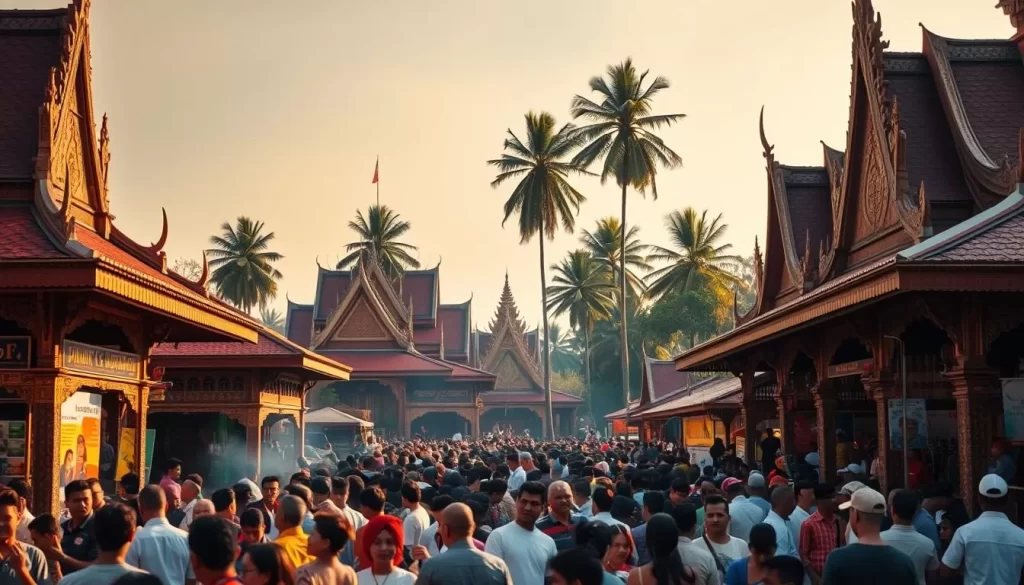
Following this guide will help you navigate the complexities of Cambodian festivals, ensuring a rewarding experience.
Conclusion
Cambodia’s festivals offer a unique window into the country’s rich cultural heritage and spiritual practices. As you’ve seen, the diverse range of festivals covered in this guide, from the joyous celebrations of Khmer New Year to the solemn observances of Pchum Ben, provide a profound cultural immersion experience for travelers.
By planning your Cambodia travel itinerary around these festivals, you’ll not only witness the country’s vibrant culture but also connect with the locals on a deeper level. Each festival reveals different aspects of Cambodian identity, including its agricultural roots, Buddhist faith, reverence for ancestors, and royal traditions.
As you approach these celebrations with respect, curiosity, and openness, you’ll be rewarded with meaningful connections and unforgettable experiences. With numerous local and regional festivals throughout Cambodia, you’ll find ample opportunities for cultural discovery. We encourage you to experience at least one Cambodian festival during your visit to truly understand the heart of this remarkable country.
